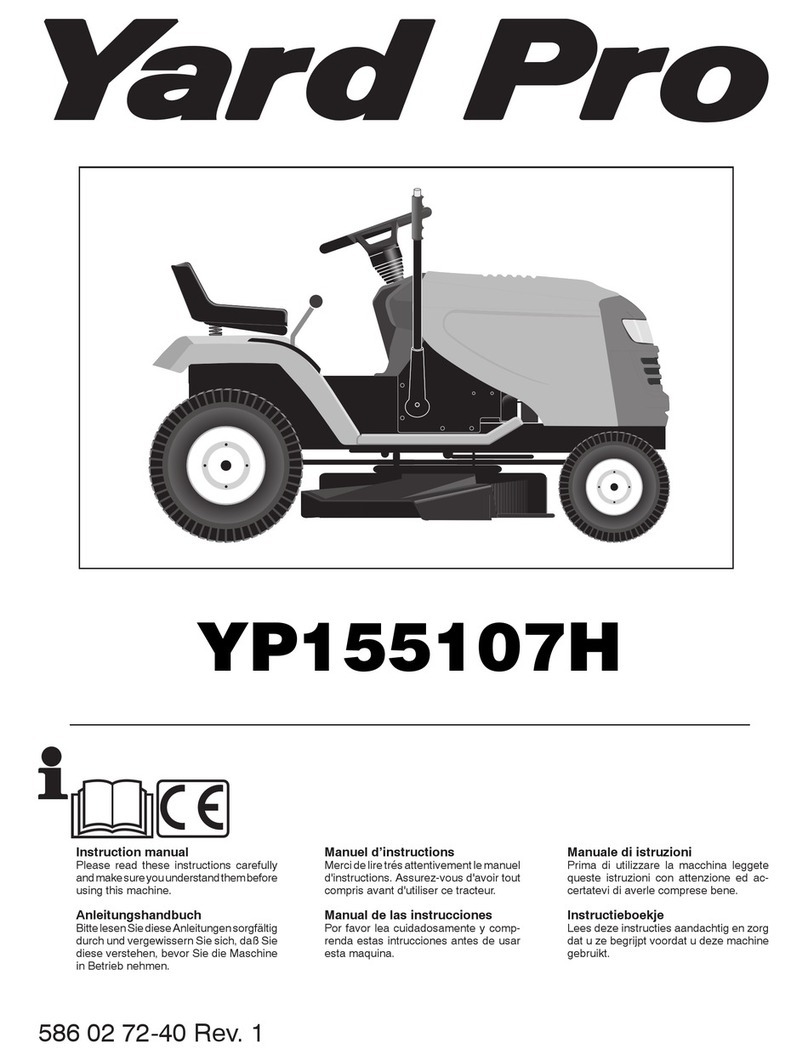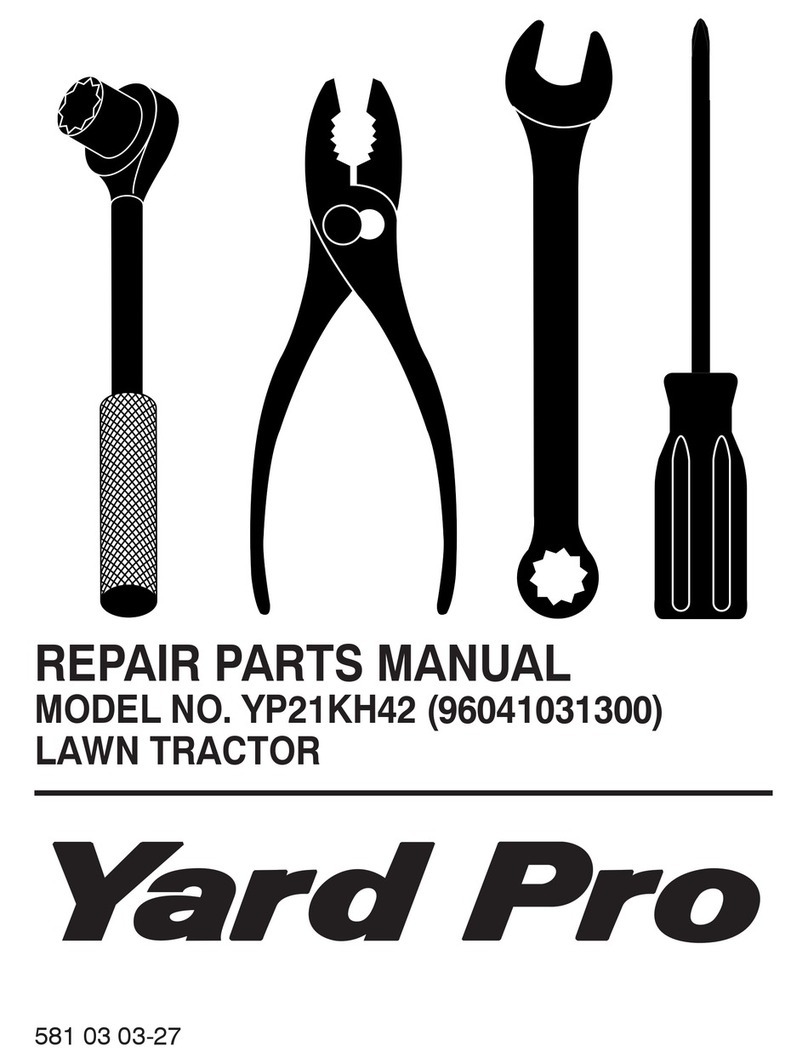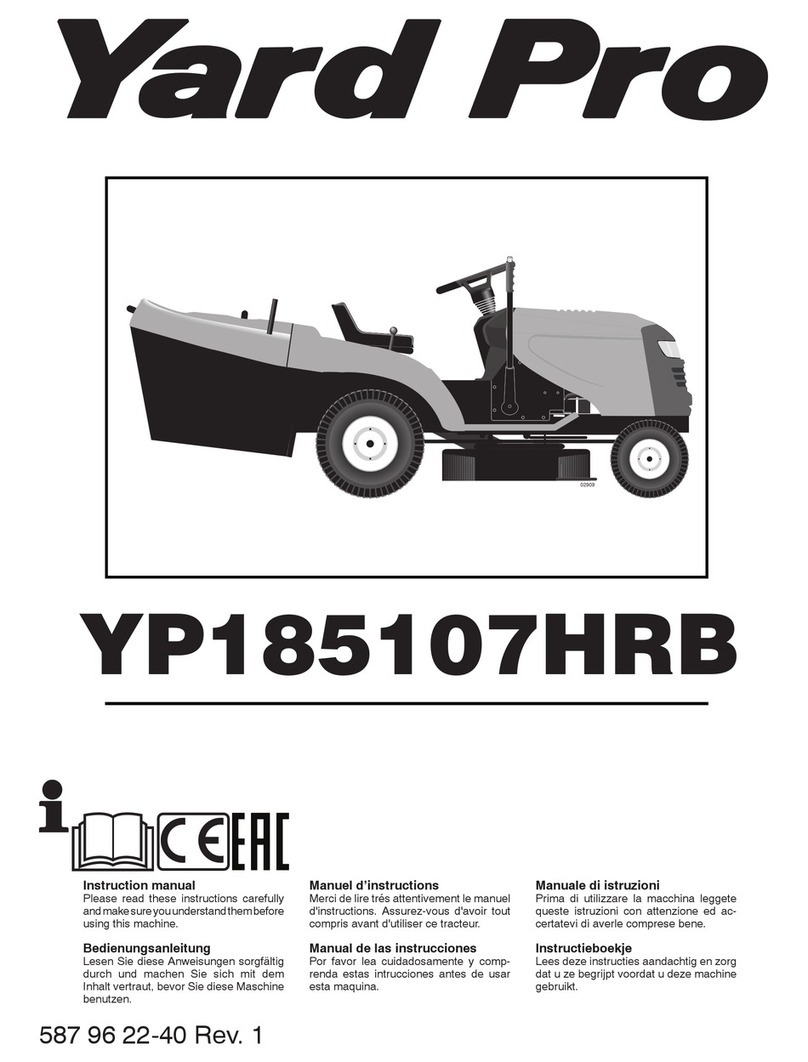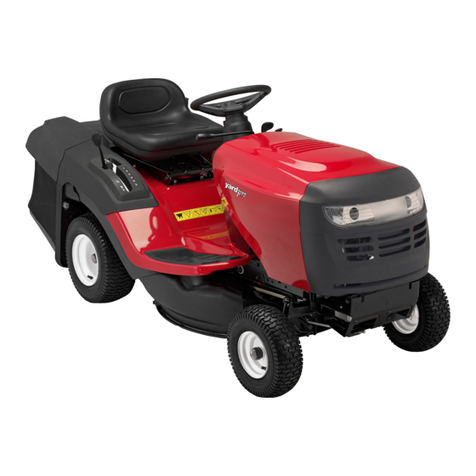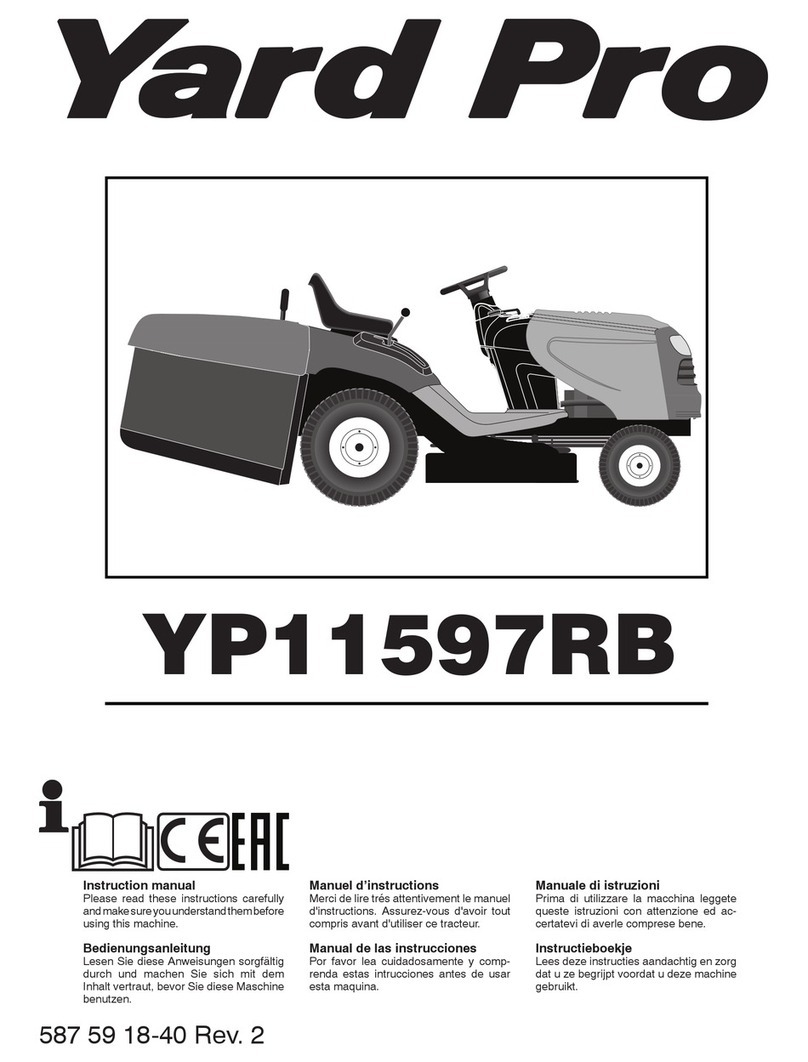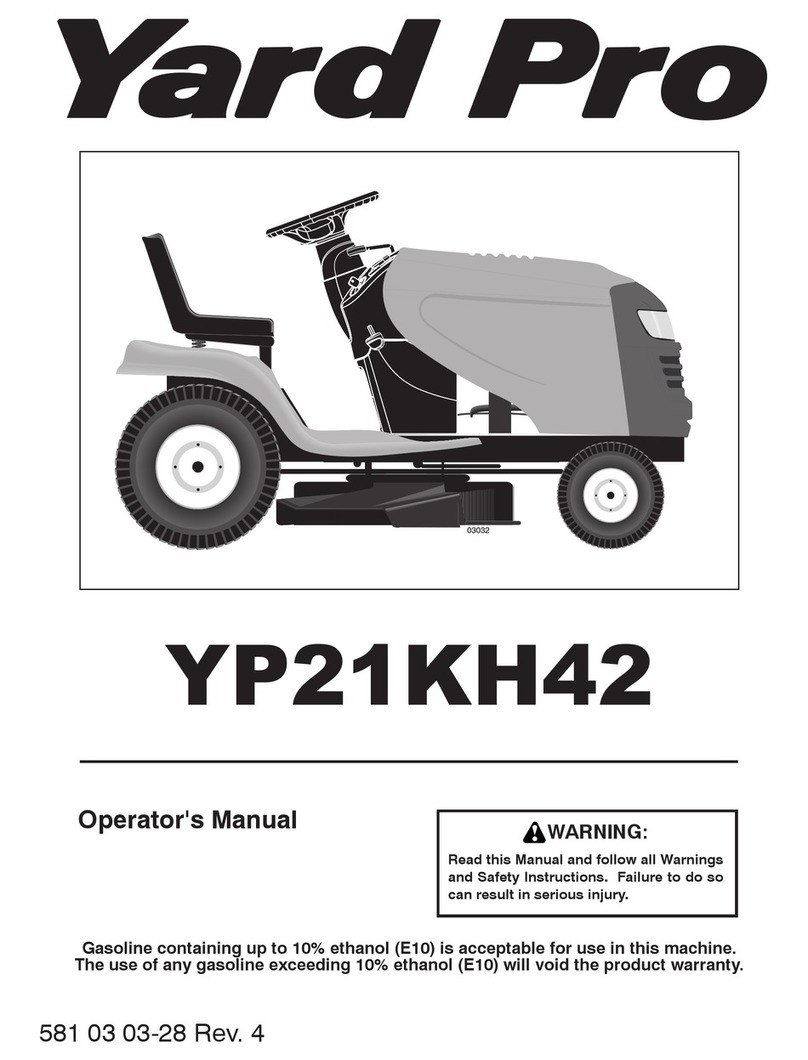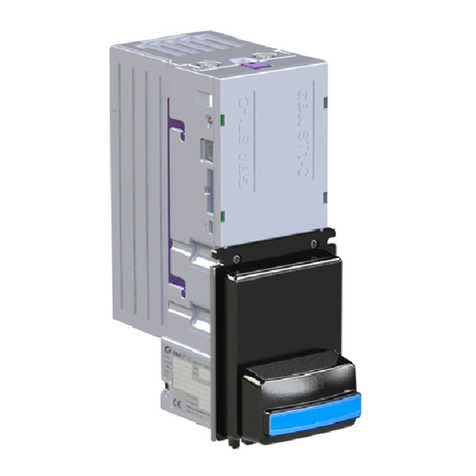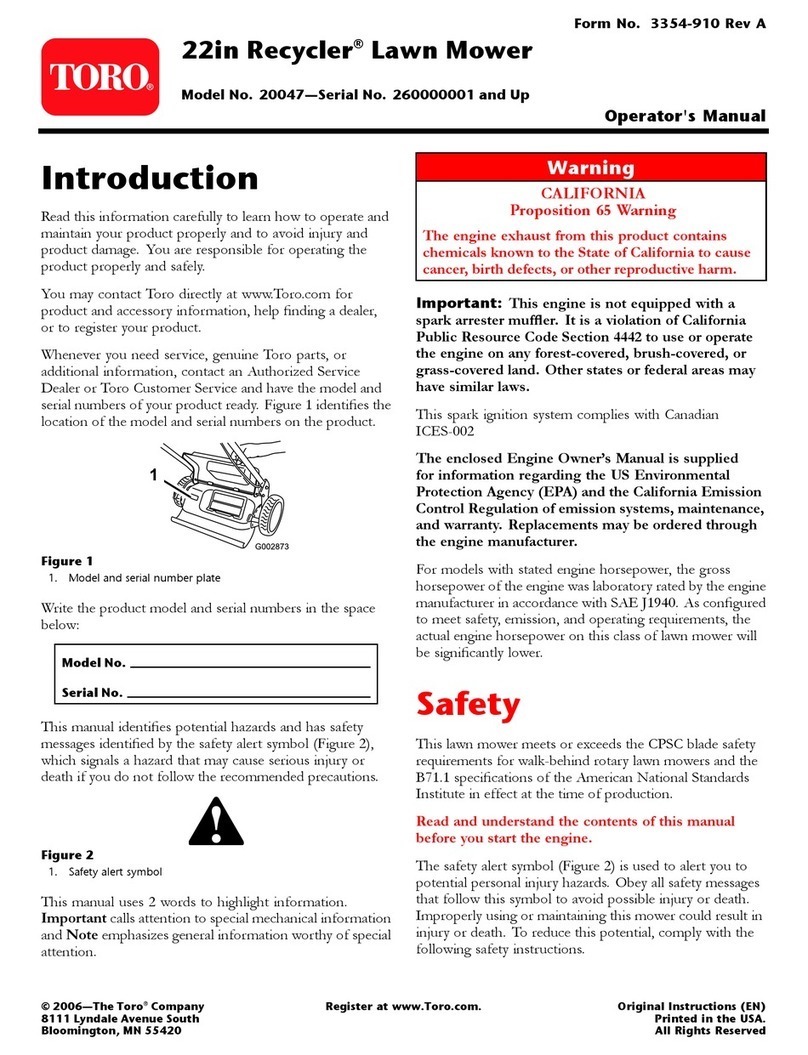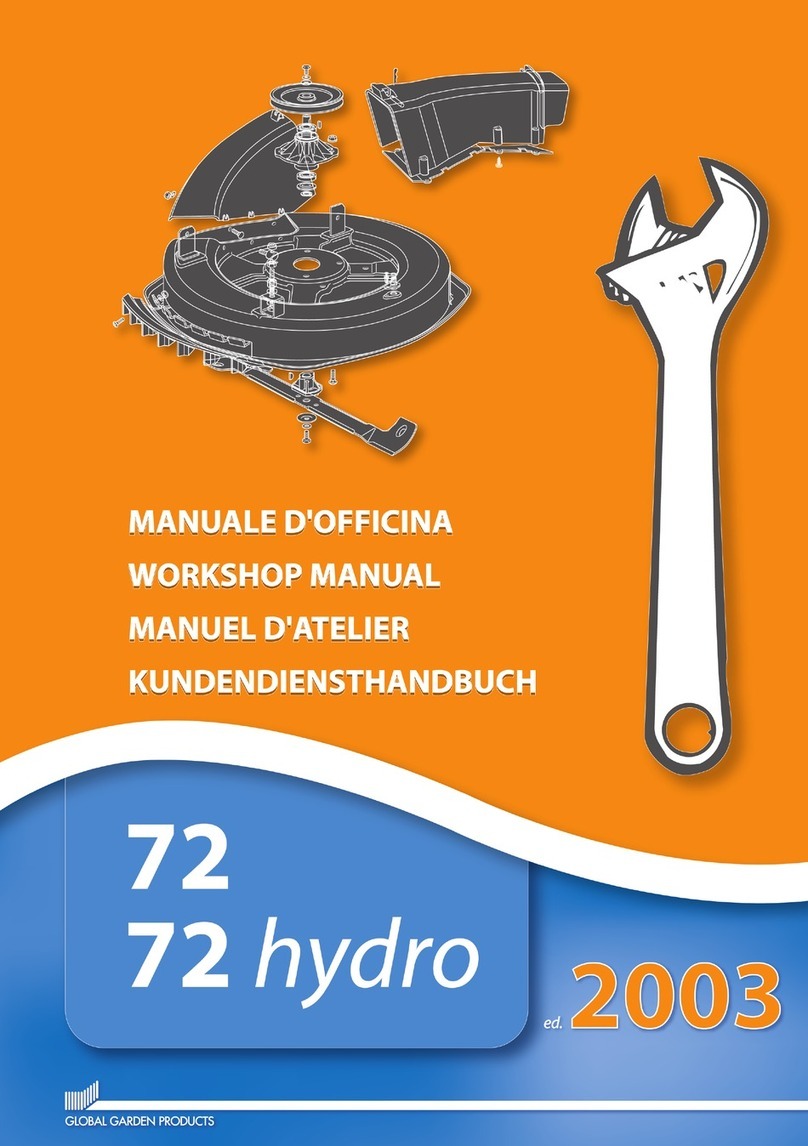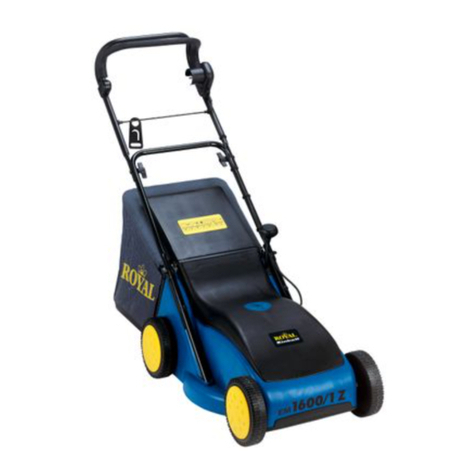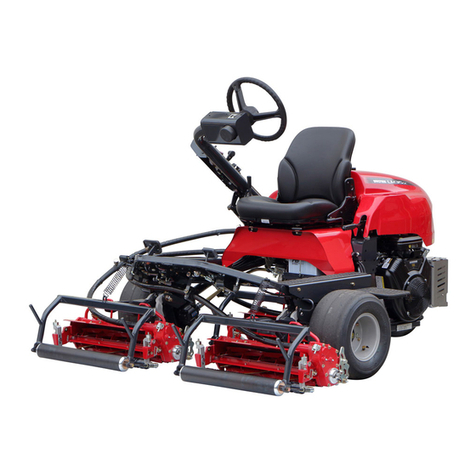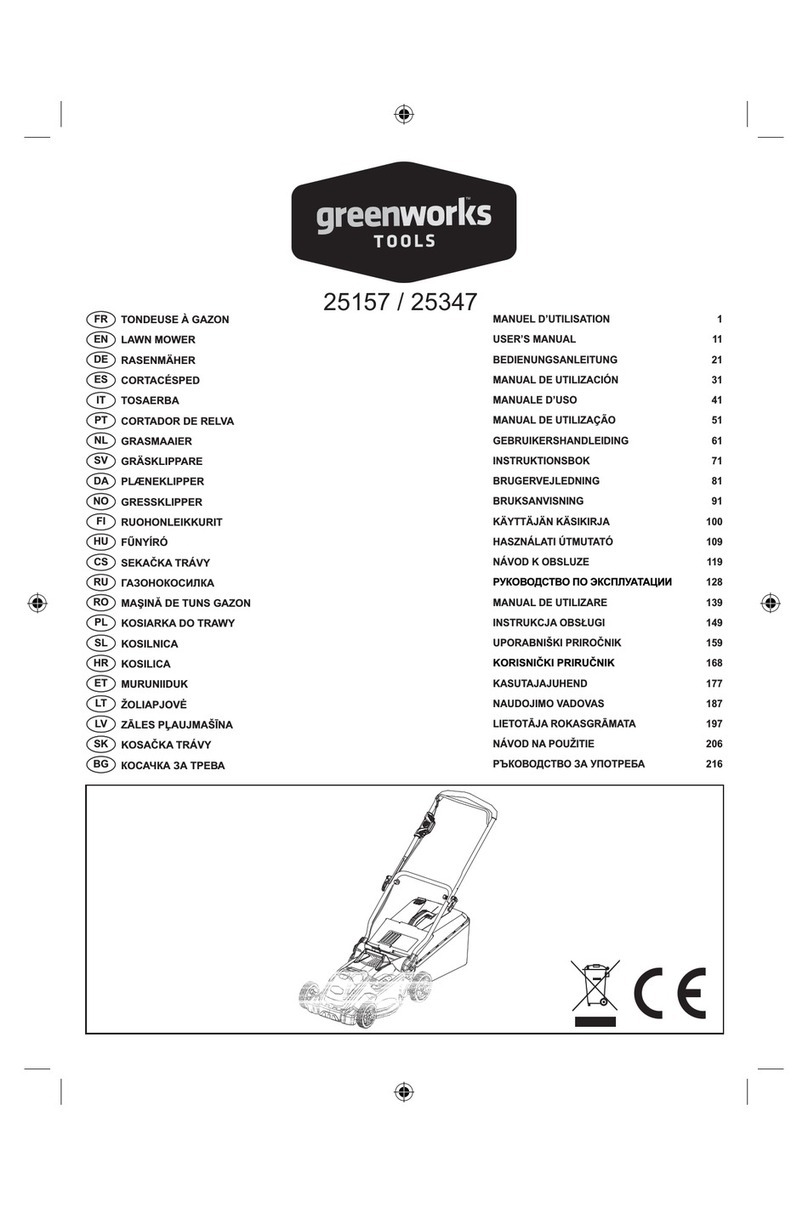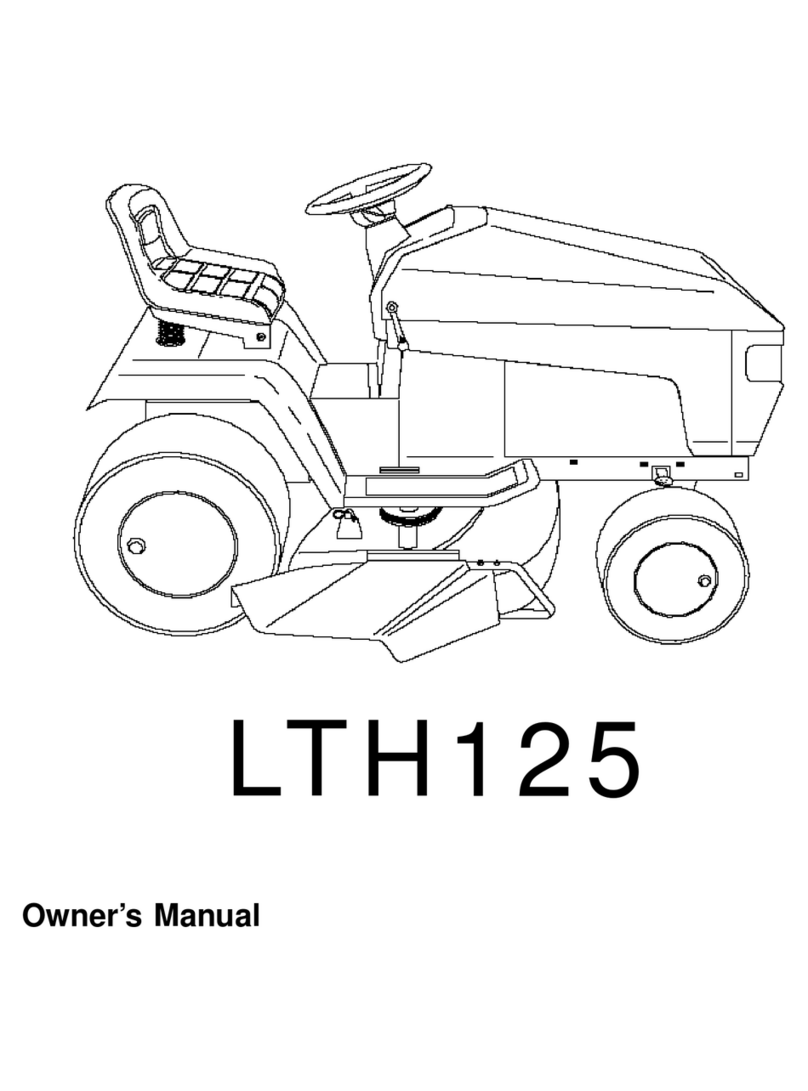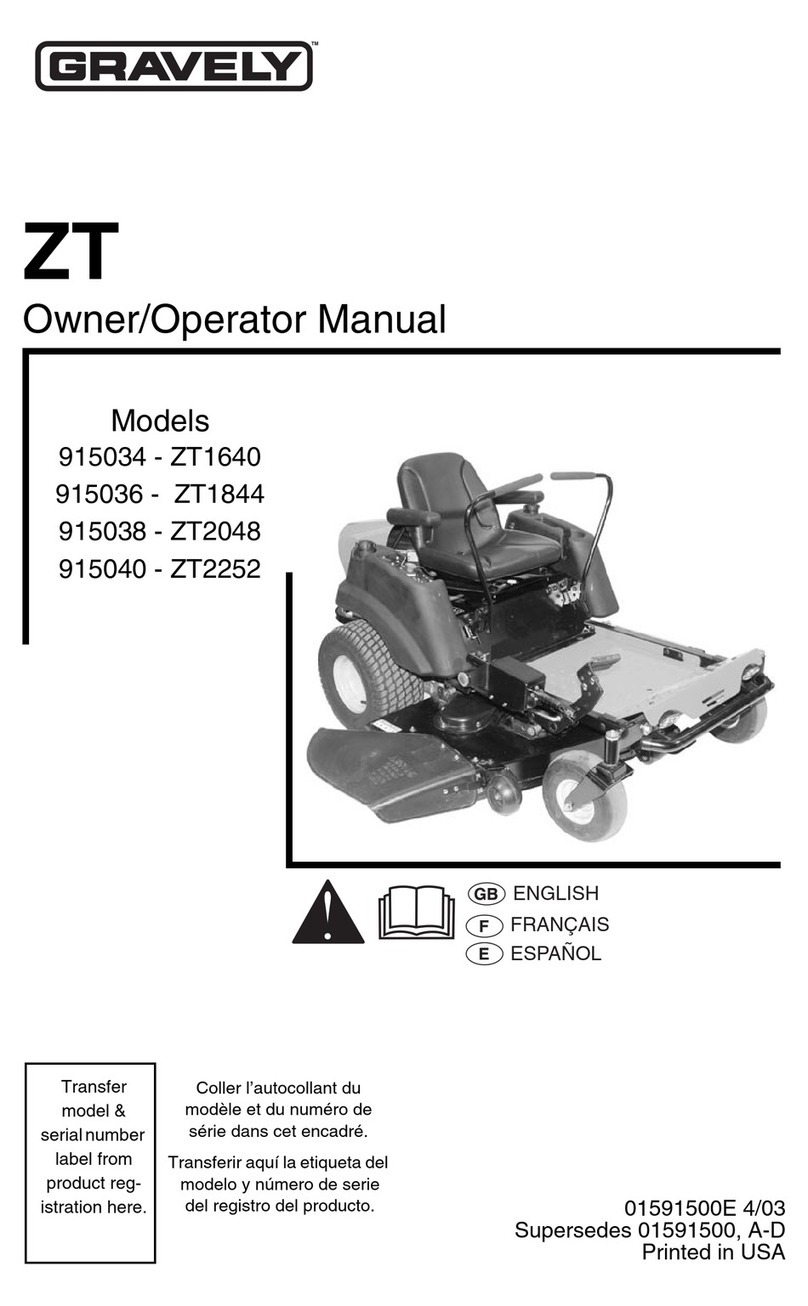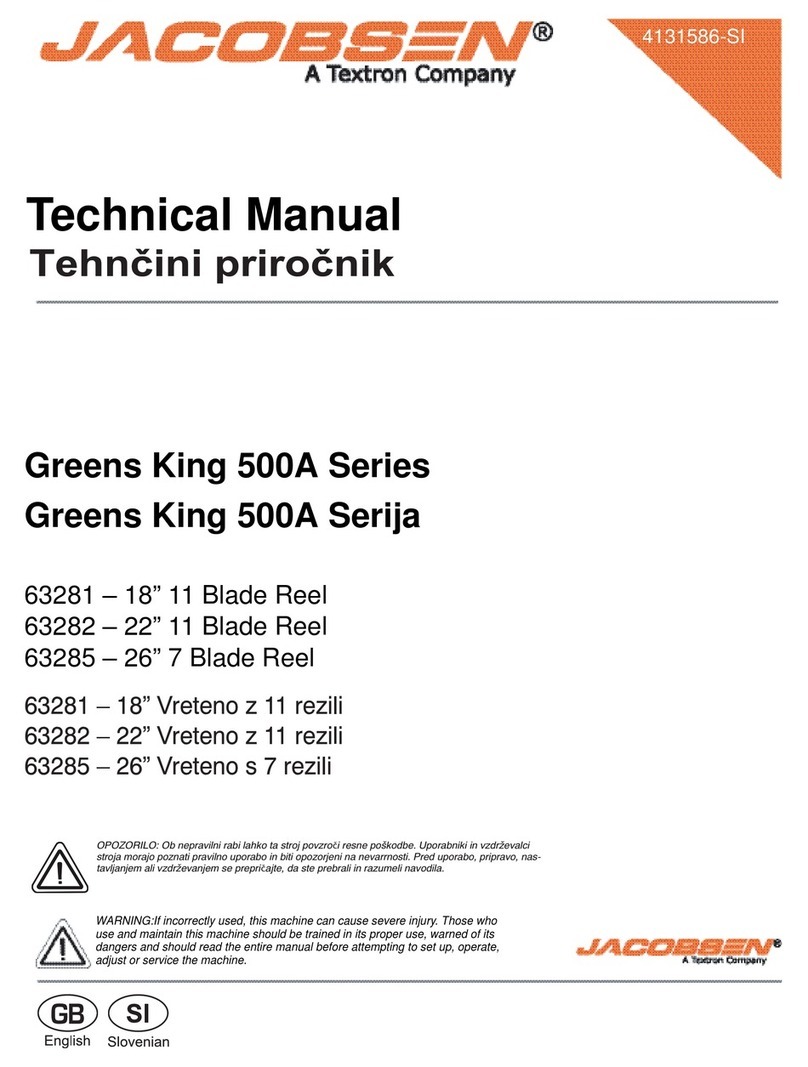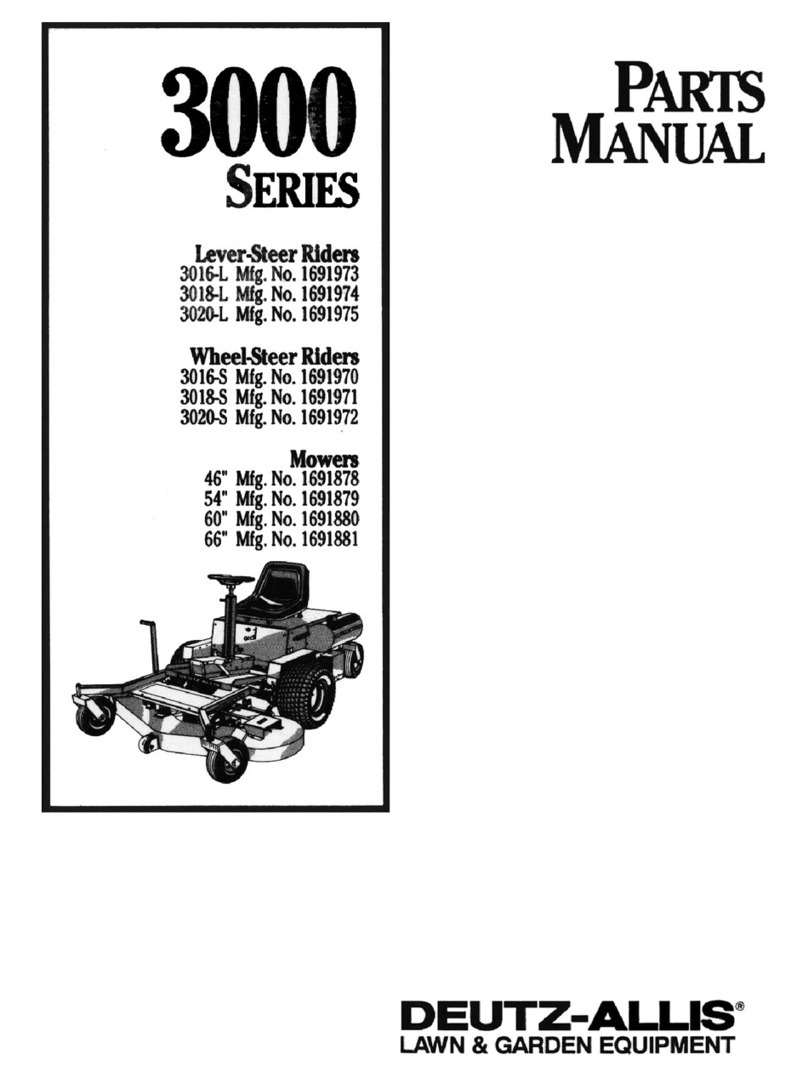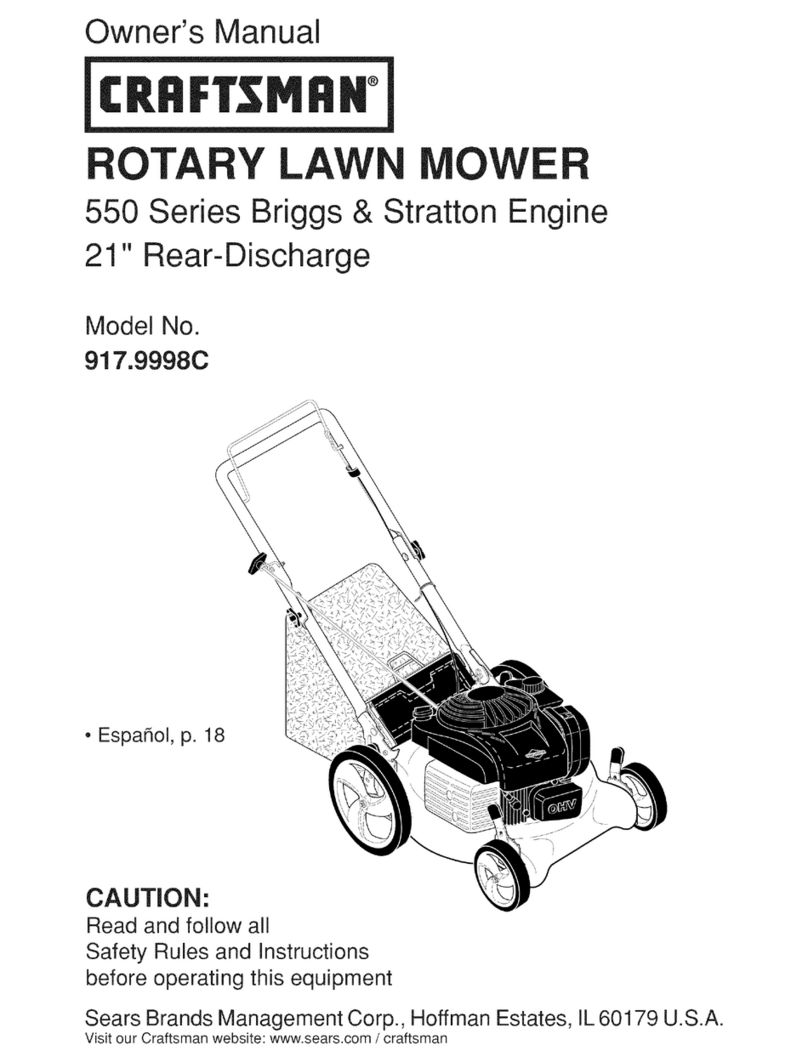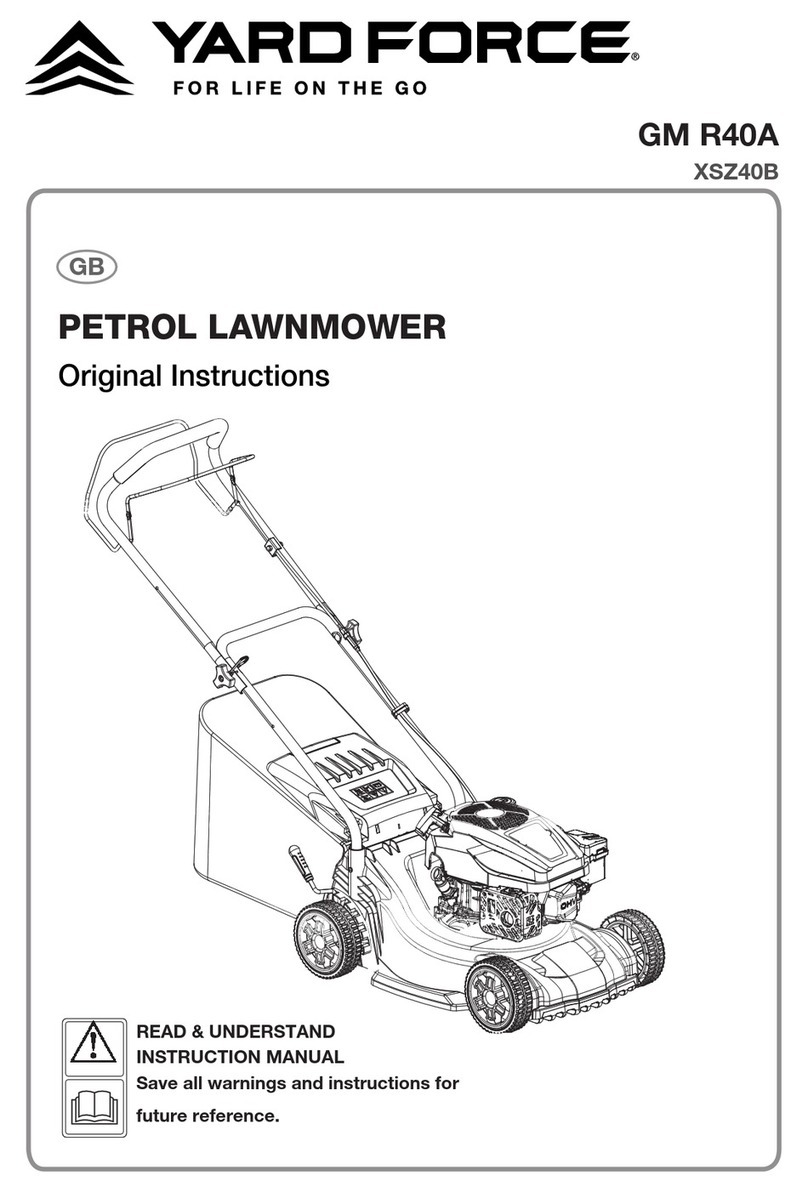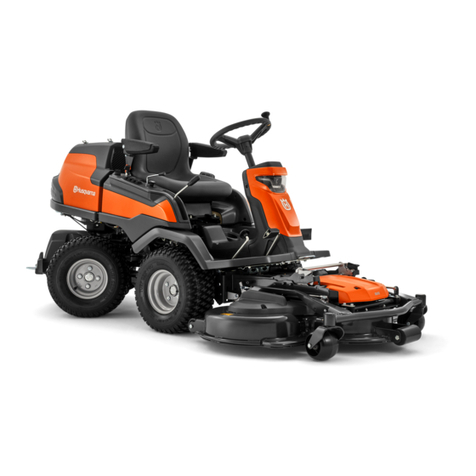
5
1. Sicherheitsvorschriften
Regeln für die sichere Bedienung von Rasentraktoren
WICHTIG:DIESEMÄHMASCHINEKANNHÄNDEUND FÜSSEABTRENNENUNDGEGENSTÄNDEMITHOHER GESCHWINDIGKEIT
SCHLEUDERN. NICHTBEACHTUNG DER FOLGENDEN SICHERHEITSVORSCHRIFTEN KÖNNTE SCHWERE ODER TÖDLICHE
VERLETZUNGEN ZUR FOLGE HABEN.
I. SCHULUNG
• Die Anleitungen sorgfältig durchlesen. Mit den Bedien-
ungselementen und der vorschriftsmäßigen Bedienung
der Maschine vertraut machen.
• Auf keinen Fall Kindern oder Erwachsenen, die mit der
Bedienungsanleitung des Mähers nicht vertraut sind,
den Betrieb der Maschine gestatten.Das Mindestalter
von Fahrern ist womöglich gesetzlich geregelt.
• Auf keinen Fall mähen, solange sich andere, besonders
Kinder oder Haustiere, im Arbeitsbereich befinden.
• Bitte denken Sie daran, daß der Fahrer oder Benutzer
für jegliche Unfälle oder Gefahren, denen andere oder
deren Eigentum ausgesetzt werden, verantwortlich ist.
• Befördern Sie keine Passagiere.
• Alle Fahrer sollten von einem Fachmann in Theorie und
Praxis unterrichtet werden. Dieser Unterricht sollte
folgende Punkte behandeln:
- die Notwendigkeit von Vorsicht und Konzentration bei
der Arbeit mit Rasentraktoren;
- daß es nicht möglich ist, die Beherrschung eines
Rasentraktors, der auf einem Abhang herabrutscht,
durch Betätigen der Bremse wieder zu erlangen.
Die Hauptgründe für den Verlust der Beherrschung über
dasFahrzeug sind:
a) ungenügende Bodenhaftung;
b) zu schnelles Fahren;
c) unzureichendes Abbremsen;
d) die Maschine ist nicht für die Aufgabe geeignet;
e) unzureichendes Bewußtsein über die Auswirkungen
von Bodenverhältnissen, besonders auf Abhängen;
f) verkehrtesAbschleppenundverkehrteLastverteilung.
II. VORBEREITUNG
• Um das Risiko eines Brandes zu reduzieren, inspizieren
Sie vor der Benutzung, beim Nachtanken und zu Ende
jeder Mahd den Traktor und den Mäher und entfernen
Sie alle Mährückstände, die sich angesammelt haben,
auch hinter allen Schutzabdeckungen.
• WährenddemMähen immer festesSchuhwerkundlange
Hosentragen. DieMaschinenicht barfuß oder mit offenen
Sandalen in Betrieb nehmen.
• Das Arbeitsgelände sorgfältig untersuchen und alle
Gegenstände, die von der Maschine aufgeschleudert
werden könnten, entfernen.
• WARNUNG - Benzin ist äußerst leicht entzündlich.
- KraftstoffinspezielldafürausgelegtenBehälternlagern.
- Nurimfreientankenundwährenddessennichtrauchen.
- Kraftstoff nachfüllen, bevor der Motor angelassen wird.
Auf keinen Fall den Tankdeckel entfernen oder Benzin
nachfüllen, solange der Motor läuft oder heiß ist.
- FallsKraftstoffverschüttet wurde,nichtversuchen, den
Motor anzulassen, sondern die Maschine vom ver-
schütteten Benzin wegschieben und das verursachen
jeglicherZündquellenvermeiden,bisdieBenzindämpfe
sich verflüchtigt haben.
- Alle Deckel wieder fest auf Kraftstofftanks und Krafts-
toffbehältern anbringen.
• Schadhafte Schalldämpfer ersetzen.
• VordemGebrauchimmermiteinerSichtprüfungsicherstel-
len, daß Mähmesser, Messerschrauben und die Mähein-
heit nicht abgenutzt oder beschädigt sind. Abgenutzte
oder beschädigte Messer und Schrauben ersetzen, um
Auswuchtung zu gewährleisten.
• Bei Maschinen mit mehreren Mähmessern ist Vorsicht
geboten,dabeim Drehen einesMähmessersdieanderen
Mähmesser sich womöglich mit drehen.
III. BETRIEB
• Maschinenichtineinemgeschlossenen Bereichbetreiben,
in dem die gefährlichen Kohlenmonoxydgase sich sam-
meln können.
• Nur bei Tageslicht oder guter künstlicher Beleuchtung
mähen.
• Alle Messerbetätigungskupplungen auskuppeln und in
den Leerlauf schalten, bevor versucht wird, den Motor
anzulassen.
• Auf keinen Abhängen mit einer Steigung von mehr als
15° mähen.
• Bittedarandenken,daßes keinen “sicheren” Abhang gibt.
BeimFahrenaufgrasbewachsenenAbhängenistbesonde-
reVorsicht geboten. UmdasÜberschlagenzuvermeiden:
- Beim Bergauf- oder Bergabfahren auf keinen Fall
plötzlich anfahren oder anhalten;
- Kupplung langsam einlegen, immer einen Gang
eingelegt lassen, besonders beim Bergabfahren;
- Die Fahrgeschwindigkeit sollte auf Abhängen und in
engen Kurven niedrig gehalten werden.
- AufBodenwellen,LöcherundandereGefahren achten;
- Niemals quer zum Abhang mähen, es sei denn, der
Rasenmäher ist speziell dafür ausgelegt.
• Beim Abschleppen von Lasten oder der Verwendung von
schwerem Gerät ist Vorsicht geboten.
- Nur zugelassene Zugstangen-Anhängepunkte ver-
wenden.
- Lastenkleingenughalten,sodaßsiesicherbeherrscht
werden können.
- KeinescharfenKurvenfahren. BeimRückwärtsfahren
vorsichtig sein.
- Gegengewichte oder Radgewichte verwenden, falls
diese in der Betriebsanleitung empfohlen werden.
• Beim Überqueren von Straßen oder dem Arbeiten in
deren Nähe, auf den Verkehr achten.
• VordemÜberquerenvonOberflächendenMähmesserant-
rieb ausschalten, es sei denn, es handelt sich um Gras.
• BeiderVerwendungvonAnbaugeräten,denMaterialaus-
wurfauf keinenFallauf Personenrichten, und niemanden
während des Betriebs in der Nähe der Maschine dulden.
• DenRasenmäherauf keinen FallmitschadhaftenSchutz-
vorrichtungen,SchildernoderohneSicherheitsausrüstung
in Betrieb nehmen.
• DieEinstellungdes Drehzahlreglers nichtändern,unddie
DrehzahldesMotorsnichtüberdieWerkspezifikationenhe-
raufsetzen. DerBetriebdesMotorsbeizuhohenDrehzahlen
kann die Gefahr von Körperverletzungen vergrößern.
• Vor dem Verlassen der Bedienposition:
- DieZapfwelleabstellenundalleAnbaugeräteabsenken.
- InLeerlaufschalten und die Feststellbremseeinlegen.
- DenMotorabstellenunddenZündschlüsselabziehen.
• AlleAnbaugeräte-Antriebeausschalten,denMotorabstel-
len und das (die) Zündkerzenkabel abziehen bzw. den
Zündschlüssel abziehen:
- vor dem Entfernen von Verstopfungen aus dem Mäh-
werk oder dem Auswurf;
- vordemPrüfen,ReinigenoderReparierendes Rasen-
mähers;
- nachdem auf ein Fremdkörper gestoßen wurde. Den
RasenmäheraufSchädenuntersuchenunddie Repar-
aturen durchführen, bevor die Maschine wieder an-
gelassen und in Betrieb genommen wird;
- falls die Maschine anfangen sollte, ungewöhnlich zu
vibrieren (sofort prüfen).
